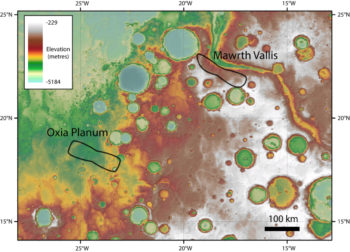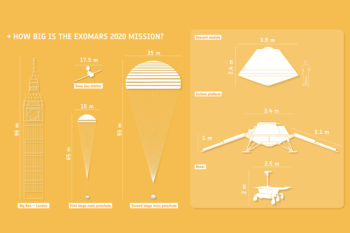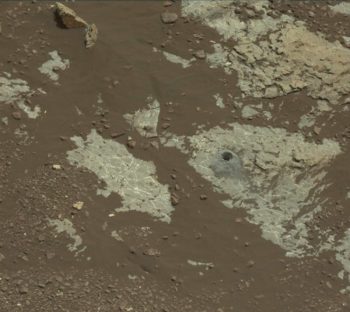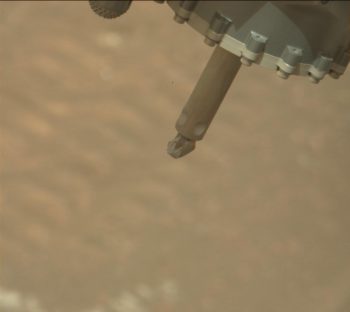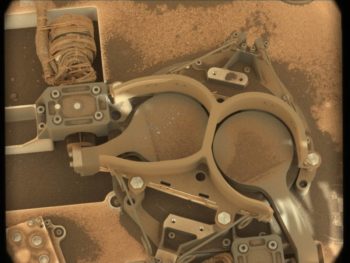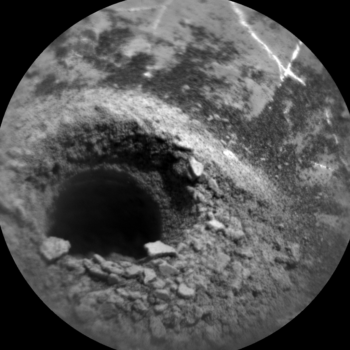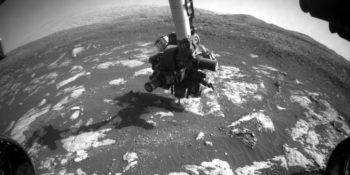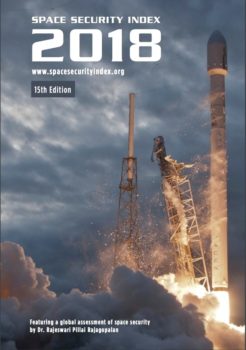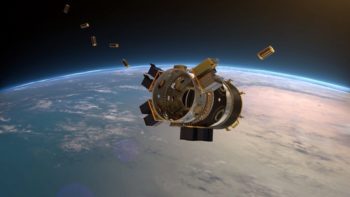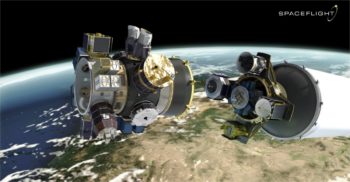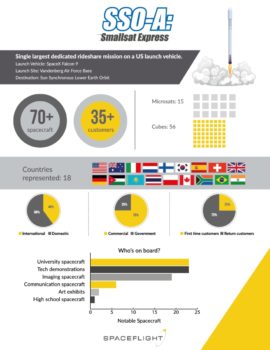Author Archive

Artist’s impression of the ExoMars 2020 rover and Russia’s stationary surface platform in background.
Credit:
ESA/ATG medialab
Mars is going to be a busy place in 2021.
The U.S., China, and Europe will attempt robotic Mars landings, with the United Arab Emirates slated to send an orbiter towards the Red Planet.
The increasing pace of Mars exploration was shown last week by an ExoMars Landing Site Selection Working Group recommendation of Oxia Planum as the touchdown locale for the European Space Agency-Roscosmos rover and surface science platform that will launch to the Red Planet in 2020.
Clear winner
This proposed landing site will be reviewed internally by ESA and Roscosmos with an official confirmation expected mid-2019. Previously, Oxia Planum and Mawrth Vallis have both been under active study. Oxia Planum has been deemed “the clear winner” on both science and engineering constraints.
The ESA-led rover and Roscosmos-led surface science platform will launch in the July 25-August 13, 2020 launch window on a Proton-M rocket from Baikonur, Kazakhstan, and cruise to Mars in a carrier module containing a single descent module, arriving at Mars March 19, 2021.
Mars underground
At the heart of the ExoMars program is the quest to determine if life has ever existed on Mars. The ExoMars rover will travel across the Martian surface and drill down 6 feet (2 meters) depth to determine if evidence of life is buried underground.
Oxia Planum lies at the boundary where many channels emptied into the vast lowland plains. Observations from orbit show that the region exhibits layers of clay-rich minerals that were formed in wet conditions some four billion years ago, likely in a large body of standing water.
Also, Oxia Planum offers a safety margin for entry, descent and landing, as well as terrain that the rover can easily navigate to sites of scientific interest.
The ExoMars landing ellipse has low elevation and contains very few topographic obstacles or challenging slopes.

Mars Hand Lens Imager (MAHLI) image produced on Sol 2224, November 8, 2018. MAHLI is located on the turret at the end of the rover’s robotic arm
Credit: NASA/JPL-Caltech/MSSS
Now in Sol 2226, NASA’s Curiosity Mars rover is performing post-drilling tasks – the 18th drill hole completed by the robot.
New imagery from Curiosity shows the new drill site and self-inspection.
China’s new rockets, Long March-9, Long March-8 and Smart Dragon, were presented at the China International Aviation and Aerospace Exhibition, in Zhuhai, Guangdong Province.
Long March-9 (Chang Zheng-9) is a heavy-lift launch vehicle designed to carry a payload of 140 tonnes into low-Earth orbit and 50 tonnes into Earth-Moon transfer orbit.
China plans to launch Long March-9 around 2030.
Long March-8 (Chang Zheng-8) is a medium-lift launch vehicle, expected to make its maiden flight in 2020.
Smart Dragon No.1 or Lightning Dragon No.1 is the first rocket in the Lightning Dragon series, developed by ChinaRocket under the China Aerospace Science and Technology Corporation.
For this CCTV video, go to:
https://youtu.be/G6y_vBaIALo?list=PLpGTA7wMEDFjz0Zx93ifOsi92FwylSAS3

This artist’s rendering illustrates a conceptual design for a potential future mission to land a robotic probe on the surface of Jupiter’s moon Europa.
Credit: NASA/JPL-Caltech
Space scientists have been pinning their astrobiological hopes for a lander mission to Europa using political glue. Given the midterm elections, has the Europa lander project been put on ice?
As reported by FYI of the American Institute of Physics (AIP) and posted here with permission:
Rep. John Culberson (R-TX), who chairs the Commerce-Justice-Science Appropriations Subcommittee, lost his election in his Houston-area district.
Life beyond Earth
Culberson is an enthusiastic proponent of science and space exploration, and, since taking over as subcommittee chair in 2014, he has channeled years of funding increases to NASA, which has included adding nearly $800 million to the annual budget of the Planetary Science Division.
Culberson’s support for NASA has been driven largely by his conviction in the inherent value of its mission, and he has hoped that, with proper support, the agency will succeed in finding evidence of life beyond the Earth.

Rep. John Culberson (R-TX) examining a Europa lander model during a visit to NASA’s Jet Propulsion Laboratory.
Credit – NASA/JPL-Caltech via AIP
Accordingly, he has secured funding in recent budget cycles to advance two missions to Jupiter’s moon Europa. However, Culberson’s enthusiasm for space research was turned against him by his Democratic opponent, who accused him of not paying enough attention to Earth-bound problems such as the flooding from Hurricane Harvey.
Europa Clipper
There is agreement in the government that the Europa Clipper, which will perform multiple flybys, should be supported.
However, the Obama and Trump administrations have resisted Culberson’s push for a follow-on lander and an aggressive launch schedule for both missions.
A recent National Academies report also noted that the lander mission has not been properly vetted as a priority by the scientific community. Even in the minority, Culberson might have been a forceful advocate for his priorities. In his absence, momentum behind the lander could dissipate, and the fate of the budget increases he has marshalled for NASA remains to be seen.
Science agencies
Culberson’s subcommittee also has jurisdiction over the National Science Foundation, National Oceanic and Atmospheric Administration, and National Institute of Standards and Technology.
In general, Culberson has been favorably disposed to those agencies, though the subcommittee has recommended cuts to certain programs. However, Ranking Member José Serrano (D-NY) and other subcommittee Democrats have also spoken positively of the need to fund science agencies robustly.
For the full FYI AIP report, go to:
https://www.aip.org/fyi/2018/2018-midterm-election-results-outlook-science-policy
For the Europa Lander Study 2016 Report, go to:
https://europa.nasa.gov/resources/58/europa-lander-study-2016-report/
NASA’s Curiosity Mars rover is now in Sol 2225 following a successful drilling in the “Highfield” target.
Reports Claire Newman, an atmospheric scientist at Aeolis Research in Pasadena, California: “Our eighteenth drill hole in the martian surface!”
“Not quite a ‘hole in one,’ as we tried to sample the same gray Jura rock type about 50 sols ago, but we finally have a sample of our highest value target on Vera Rubin Ridge,” Newman adds. “Rather than retreat to the club house for a well-earned celebration, however, Curiosity and the team stayed busy in Sol 2225, doing Mastcam and Chemistry and Camera (ChemCam) imaging of the new drill hole and tailings.”
Weekend plan
A weekend plan calls for further imaging of the drill hole and use of ChemCam’s Laser-Induced Breakdown Spectrometer (LIBS). Samples are to be dropped off to the rover’s Chemistry & Mineralogy X-Ray Diffraction/X-Ray Fluorescence Instrument (CheMin) for further analysis.

Curiosity Front Hazcam Right A photo acquired on Sol 2225, November 9, 2018.
Credit: NASA/JPL-Caltech
“In addition, there’s a packed program of environmental science over the next few sols, now that we’re back to full science operations,” Newman explains. “The global dust storm may have decayed, but we’re still interested in seeing whether the post-storm atmosphere differs compared to the same season in previous Mars years when no big storm occurred.”
Convective vortices
Newman points out that the robot is still in the middle of southern summer, which means lots of ‘dust devils’ (dust-filled convective vortices) and more dust than usual in the atmosphere.
“So in addition to our regular meteorological (REMS), radiation (RAD), and sub-surface (DAN) monitoring, we added atmospheric opacity measurements and a 360° dust devil survey,” Newman adds. “Over the weekend, alongside the drill sample analysis, there will be a bumper crop of atmospheric activities.”
Sky survey
Those activities include characterizing the amount and size distribution of dust and water ice aerosols at different times of sol, in and above the crater, by means of a Mastcam ‘sky survey’ and opacity measurements, a ChemCam ‘passive sky’ activity, and Navcam cloud movies. “We’ll also take a dust devil movie as well as two more dust devil surveys.” Newman says.
Martian wind
“And finally, over the next few sols we’ll be watching those drill tailings to see how quickly the martian wind moves them away and in what direction,” Newman says.
Also to be taken by Curiosity are ‘change detection’ images of below the rover with the Mars Descent Imager (MARDI), and of nearby grains and ripples with Mastcam, “again to see what the wind is doing at this time of year in our current location on the slope of Aeolis Mons,” Newman concludes.
NASA’s Curiosity Mars rover is now performing Sol 2224 tasks.
On Sol 2222, Curiosity drove over 30 feet (roughly 10 meters) towards the “Lake Orcadie” location.
Reports Lauren Edgar, a planetary geologist at the USGS in Flagstaff, Arizona the hopes are that the robot will be able to drill the gray Jura member there.
A new plan is focused on characterizing the target “Highfield,” a bright patch of outcrop and included pre-planned activities as part of standard drill site characterization.
Drill target prep
First Alpha Particle X-Ray Spectrometer (APXS) will carry out a short integration on the intended drill target, followed by two Mars Hand Lens Imager (MAHLI) images.
Then the plan calls for use of the Dust Removal Tool to brush the target, followed by Mastcam imaging and a full suite of MAHLI images.
“Then we’ll do a drill pre-load test, which means that we’ll put weight on the drill bit to make sure the surface can support it,” Edgar notes, “and if it makes marks on the surface this might give us an indication of how hard or soft the surface is.”
Optimistic on sampling
Overnight, Curiosity will acquire a longer APXS integration on “Highfield.”
“We were pretty tight on both power and data volume…so it was a bit of a challenge to prioritize everything, but we’re optimistic that this will be our chance to sample the gray Jura member,” Edgar adds. “I’m eagerly awaiting our downlink and hoping that we’ll be ‘go’ for a full drill hole here!”
Curiosity Mastcam Left image taken on Sol 2222, November 6, 2018.
Credit: NASA/JPL-Caltech/MSSS

Mars Hand Lens Imager (MAHLI) photo acquired on Sol 2223, November 7, 2018. MAHLI is located on the turret at the end of the rover’s robotic arm.
Credit: NASA/JPL-Caltech/MSSS
The Space Security Index 2018 has been published by the Canadian peace-and-security think tank, Project Ploughshares.
Among key findings is noting the deteriorating security conditions in outer space in the absence of renewed governance efforts.
The just-issued report underscores:
Plans for mega-constellations of satellites that outpace sustainability rules;
A drive toward next-generation space exploration and resource extraction by private actors;
The emergence of dual-use technologies such as debris removal, satellite servicing, and maneuvering capabilities;
Continuing development and demonstration of anti-satellite capabilities;
U.S. plans for space-based ballistic missile interceptors that could mark the first deployment of space-based weapons.
Voluntary guidelines
Space Security Index 2018 also underscores the work of the UN Committee on the Peaceful Uses of Outer Space (COPUOS) that reached consensus on 21 voluntary guidelines to enhance the long-term sustainability of space activities.
In a press statement, Project Ploughshares project manager Jessica West explains that the growing geostrategic tension and mistrust discourage the development of constraints on the use of force in outer space. This lack of regulation has serious repercussions.
Space access
West asserts that space security is global security. Every facet of well-being – military security, humanitarian security, socioeconomic security, and environmental security – depends on the ability to access and use services from outer space. Dangerous activities could pollute the outer-space environment beyond repair through the production of space debris, limiting or ending such services.
Space Security Index 2018 was produced by civil society and academic organizations under the leadership of Canadian nonprofit organization Project Ploughshares. Partners include The Simons Foundation Canada; the Institute of Air and Space Law at McGill University in Montreal, Quebec; the Space Policy Institute at The George Washington University in Washington, DC; the Research Unit on Military Law and Ethics at the University of Adelaide Law School in Australia; and the School of Law at Xi’an Jiaotong University in China.
For a copy of the report, go to:
http://spacesecurityindex.org/wp-content/uploads/2018/06/C014894_space.security.2018-hires.pdf
A red flag has been raised by a satellite and orbital debris analyst regarding the upcoming launch of SSO-A, currently scheduled for liftoff from Vandenberg Air Force Base in California on November 19.
The bragging rights about the SmallSat Express involve the largest rideshare mission from a U.S.-based launch vehicle – SpaceX Falcon 9 booster — with 25 percent of the customers launching for the first time.
Targeted for sun-synchronous orbit (SSO), the mission is dubbed SSO-A: SmallSat Express.
Mission management provider, Spaceflight, has contracted with more than 70 spacecraft from approximately 35 different organizations, all to be propelled skyward by a SpaceX Falcon 9. Spaceflight is a service offering of Spaceflight Industries, based in Seattle, Washington.
Perhaps in a bit of irony, the 18th Space Control Squadron at Vandenberg Air Force Base is tasked with providing 24/7 support to the space sensor network, maintaining the space catalog and managing United States Strategic Command’s (USSTRATCOM) space situational awareness (SSA) sharing program to United States, foreign government, and commercial entities.
SHERPA platforms
“What they [Spaceflight] haven’t shared is how these 70+ satellites are going to be deployed,” says T.S. Kelso of CelesTrak, an analytical group that keeps an eye on Earth-orbiting objects. “I checked with one of the operators—trying to get a head start on how we’re going to ID all of these—and learned that the two SHERPA platforms are going to be released from the Falcon 9 with no attitude control or attitude determination.”
SHERPA is a free-flying secondary payload dispenser.
Kelso’s bottom line: “I think this is not only irresponsible from a safety of flight perspective, but it jeopardizes the time and resources of many of the small operators who may never even hear from their satellites,” he told Inside Outer Space.
Space debris
Kelso says that his guess is that about a third of the satellites released will basically be space debris on release.
The SHERPA platforms will be in uncontrolled tumbles as they release these payloads. Since there will be no thrusting between deployments (with no attitude control), everything will likely be released into a big cloud. The only initial information satellite operators will have will be the post-deployment state vectors from SpaceX for the two SHERPA platforms, Kelso adds.
Sorting out the mess
Cautions Kelso, there will be difficulties in sorting out this kind of mess.
“Having 70+ objects—many of which look the same to a radar—will result in observations being assigned to multiple tracks and causing bad orbits, which further compounds track association,” Kelso notes. “Until good tracks exist, it is impossible to ID the satellite…if you are a small operator and can’t find your satellite, you may be unable to do things required to keep that satellite healthy, like deploying arrays or controlling power usage.”
In a recently posted paper, “Challenges Identifying Newly Launched Objects” — Kelso outlines this issue:
https://celestrak.com/publications/IAC/2017/
Go to this video about Spaceflight’s SSO-A integrated payload stack:
https://www.youtube.com/watch?time_continue=10&v=9BEx1umVTTY

Taking the high road, aerial platforms could open up a new era of Venus exploration according to a new study.
Credit: Tibor Balint/JPL
Hellish and cloud-enveloped Venus is a world ready and waiting for renewed exploration.
A new Jet Propulsion Laboratory study released last month argues that the time is ripe to investigate Venus by high-tech aerial platforms.
These platforms can extensively probe the Venus atmosphere, its circulation, and also determine the chemical nature of the planet’s gaseous atmosphere and its clouds.

Google’s Loon program, an Earth network of long-lived balloons, is showcasing how similar technology might be applied to the next round of Venus investigation.
Credit: Loon LLC
Surprisingly, the back to Venus campaign has benefited by Google’s Loon program, an Earth network of long-lived balloons designed to deliver connectivity to people in Internet-deprived communities.
Take a look at my new Scientific American story:
Will NASA’s Next Mission to Venus Be a Balloon?
https://www.scientificamerican.com/article/will-nasas-next-mission-to-venus-be-a-blimp/
There are those paranoid about letting any starfolk know we’re here, cringing on planet Earth.
But a new MIT study suggests that existing laser technology could be fashioned to attract alien astronomers – sort of an E.T. we’re home “porch light.”
The research stems from James Clark, a graduate student in MIT’s Department of Aeronautics and Astronautics and Clark’s advisor, Associate Professor Kerri Cahoy. The “feasibility study,” appears today in The Astrophysical Journal.
On the beam
The findings suggest that if a high-powered 1- to 2-megawatt laser were focused through a massive 30- to 45-meter telescope and aimed out into space, the combination would produce a beam of infrared radiation strong enough to stand out from the Sun’s energy.

The required laser power of 1 to 2 megawatts is equivalent to that of the U.S. Air Force’s Airborne Laser, a now-defunct megawatt laser that was meant to fly aboard a military jet for the purpose of shooting ballistic missiles out of the sky.
Credit: U.S. Air Force
Such a signal could be detectable by alien astronomers performing a cursory survey of our section of the Milky Way — especially if those astronomers live in nearby systems, such as around Proxima Centauri, the nearest star to Earth, or TRAPPIST-1, a star about 40 light-years away that hosts seven exoplanets, three of which are potentially habitable.
If the signal is spotted from either of these nearby systems, the study finds, the same megawatt laser could be used to send a brief message in the form of pulses similar to Morse code.
Detectable signal
“This would be a challenging project but not an impossible one,” Clark says in a MIT press statement.
“The kinds of lasers and telescopes that are being built today can produce a detectable signal, so that an astronomer could take one look at our star and immediately see something unusual about its spectrum,” Clark adds. “I don’t know if intelligent creatures around the Sun would be their first guess, but it would certainly attract further attention.”
Clarks says such a laser beacon could be installed on the far side of the Moon. “In general, this was a feasibility study. Whether or not this is a good idea, that’s a discussion for future work.”
Note: Story adapted from Jennifer Chu/MIT News Office release.
To access the paper — “Optical Detection of Lasers with Near-term Technology at Interstellar Distances” – by James R. Clark and Kerri Cahoy, go to:
http://iopscience.iop.org/article/10.3847/1538-4357/aae380/pdf
